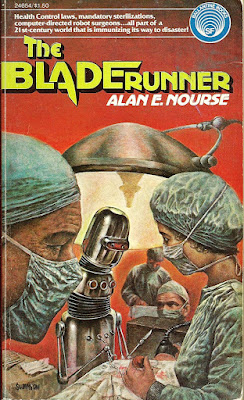Book Review: 'From the Heart of Darkness' by David Drake
'From the Heart of Darkness' (320 pp.) was published by Tor Books in November, 1983, with cover art by Michael Whelan.
The book is long out of print and copies in good condition have steep asking prices. I was able to find a rather beat-up copy for an affordable price.
'Heart' compiles short stories Drake wrote over the interval from 1974 to 1983; these appeared in publications such as Omni, Whispers, and The Magazine of Fantasy and Science Fiction. One story, 'Out of Africa', is original to this anthology.
The book features an Introduction by Karl Edward Wagner, who provides details on Drakes' career as a writer, and remarks:
Drake's fiction usually has a very strong effect upon the reader. Some readers find his work extremely unpleasant- enough so to write angry letters to the editor or inveigh against him in reviews.
Of course, by the standards of the 'quiet horror' aesthetic that dominated horror fiction during the 1970s and most of the 80s, Drake's stories did have a more gruesome edge to them.
But it's also ironic to note that as a co-editor of Whispers, Drake was less than welcoming to submissions that had a transgressive quality. This also was true of Wagner's editorship of the DAW Books series The Year's Best Horror Stories...........
Anyways, my capsule reviews of the contents of 'From the Heart of Darkness':
Men Like Us (1980): in post-apocalyptic America, not all settlements are particularly welcoming to strangers.
Something Had to be Done (1975): one of a number of tales in the anthology that uses the Vietnam War (in which Drake served) as a backdrop. In this story, a team sets out to deliver bad news to a soldier's family.
The Automatic Rifleman (1980): some anarchists are up to no good.
Than Curse the Darkness (1980): Lovecraftian hijinks in deepest, darkest Africa. The prose is painfully stilted; this is the first time I ever have encountered the simile '......like an ant run blown by carbon disulphide.'
Firefight (1976): U.S. soldiers fighting in Vietnam choose a bivouac location with a disturbing history.
The Red Leer (1979): sometimes Indian burial mounds are better left alone. A decent 'monsters on the loose' tale.
The Shortest Way (1974): a 'Vettius' story set in the days of the Roman empire. Our hero elects to travel on a road that the locals take care to avoid. An atmospheric tale, and one of the best entries in the collection.
Best of Luck (1978): Dog Company seems to be getting the worst of it in firefights.
Dragon's Teeth (1983): another Vettius story, this one, involving Sarmatians (Eastern European nomads), and sorcery of a particularly dangerous nature.
Out of Africa (1983): hunting big game in the swamps of the Dark Continent can be dangerous.
The Dancer in the Flames (1982): Lieutenant Schaydin is troubled by disturbing hallucinations.
Smokie Joe (1977): this first appeared in the 1977 Corgi Books anthology More Devil's Kisses, edited by 'Linda Lovecraft' (Michael Parry). The Devil's Kisses series, which were the very first so-called 'erotic horror' anthologies, have since passed into Paperback Fanatic legend: copies of More Devil's Kisses were seized by Scotland Yard, and Corgi was threatened with prosecution, for violating obscenity laws. Existing copies of the Devil's Kisses series have steep asking prices.
[ The whole controversy over More Devil's Kisses, the involvement of Scotland Yard, and - believe it or not - The National Lampoon, is so entertaining that I made it the topic of a post here at the PorPor Books Blog........ ]
'Smokie Joe' is the only horror story I am aware of that features a particularly unpleasant venereal disease as a major plot point. Is it Proto-Splatterpunk ? I'd like to think so !
Children of the Forest (1976): who knew Bigfoot roamed German forests ?!
Blood Debt (1976): overly purple prose weakens this story about Judson Rigsbee, who lives in the suburbs and practices black magic.
The Barrow Troll (1975): Ulf Womanslayer, a Viking warrior, gets wind of buried treasure and decides it should be his, even though it's guarded by a very nasty troll............
The Hunting Ground (1976): people are disappearing from an urban neighborhood in North Carolina. Lorne, a Vietnam veteran with post-traumatic stress disorder, decides to investigate. One of the better stories in the anthology.
Summing up, while Drake's prose style can at times be awkward, 'From the Heart of Darkness' is a good example of horror short fiction of the 1970s and early 80s, by a practitioner who was able to sidestep the editorial taboos on 'explicit' content that governed the genre. As such, horror fans of the 'Whispers' and 'Year's Best Horror Stories' era will find it rewarding.






























.jpg)

















